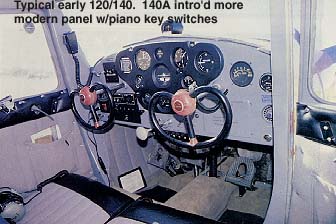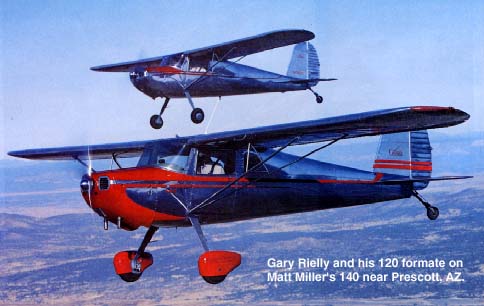 Mechanical Description
Mechanical DescriptionIf you want to know how a 120/140 is built, look at a C-150/152. Structurally, with the exception of the welded steel struts of the 120/140s, and the fabric covered wings, they are almost identical.
 Mechanical Description
Mechanical Description
If you want to know how a 120/140 is built, look at a C-150/152.
Structurally, with the exception of the welded steel struts of
the 120/140s, and the fabric covered wings, they are almost identical.
The spring steel landing gear of the 120/140 was the first large-scale application of Steve Wittman's patent and it obviously worked. There have been a few incidents of gears cracking through the rivet holes (many are now bolted) which hold the steel steps in position but a simple Zyglo test will show if there are problems there.
Other than corrosion problems typical of all old aluminum airplanes (along the rear spars or anywhere which can trap gravity-driven condensation), the airplanes have been relatively free of mechanical maladies. The most common problems include cracked elevator hinges and an occasional cracked rear fuselage bulkhead.
The brakes are one area of concern. The originals were Goodyears with floating disks held in alignment with spring clips. They used small, round brake pucks which have gotten terribly expensive and many owners machine down automotive pucks to fit (ssshhhh, the feds might hear). A much bigger worry is the possibility of a brake locking, if a retaining clip is lost and the disk cocks over and gets jammed. Converting to McCauley or Cleveland brakes is the usual fix.
Incidentally, because of the outside storage and general age of the airplanes, their wiring bundles are sometimes frayed and brittle. Check all wiring carefully.
A note about the airplane's mechanical character: This is an airplane that responds beautifully to TLC and elbow grease. Everything about it is easy to take apart for cleaning and painting.
Flying Characteristics
Each classic airplane has its own flying personality and so
does the 120-140. It's important to remember it's a post war design.
Most of its contemporaries were originally designed before the
war to perform on the A-50 or A-65 so they are smaller and lighter.
The C-120/140 is a bigger airplane and is a little heavier feeling
and flying than something like a Luscombe or a Taylorcraft. It
doesn't feel quite as much like a maple seed in the wind, as do
some of the others. Make no mistake, however, it is still a very
light airplane. Depending on the model, they'll weigh-in empty
at 950-1000 pounds and gross at 1,425 pounds (525 pounds useful).
 The first thing you'll notice on
boarding a 120/140, is that getting in isn't much of a hassle.
Although some purists de-cry the use of control wheels rather
than sticks, having the floor free of obstacles does ease entry.
The first thing you'll notice on
boarding a 120/140, is that getting in isn't much of a hassle.
Although some purists de-cry the use of control wheels rather
than sticks, having the floor free of obstacles does ease entry.
Once in, the next thing you notice is that seeing over the
nose is possible with only a slight stretch. With a cushion behind
them, the average-height pilot can see the centerline without
stretching. The cockpit is slightly narrower than the latest C-152,
but about the same as its contemporaries. This makes it fine for
the FAA-standard 170 pound pair but gets crowded rapidly as crew
dimensions increase.
Unless converted to key start, the airplane has a separate pull-to-start
handle which, to a pilot used to modern Spam cans, seems unusual.
Once the engine is running, the straight exhausts are evident
even at idle. On takeoff they really bark. It's hard to believe
we all used to fly these without headsets, as a matter of course.
No wonder we're all half-deaf.
If the tailwheel is in even remotely good shape, the airplane will taxi nearly as effortlessly as a nosewheel airplane, needing an occasional tap on the brakes to make sharp corners. The excellent visibility makes it that much easier.
Take-off performance is directly related to the amount of weight on board. As with all lightly wing loaded, low-powered airplanes, the two-place Cessnas are different airplanes solo or dual. In no case, however do they float off the ground like a Cub or Luscombe. Actually, they takeoff remarkably like a Cessna 152, although without as much ground roll.
When the tail is raised during takeoff, the spring gear is immediately noticeable because it doesn't have the solid feel of a bungee gear and "wallows" just a little. Here, it feels almost exactly like a Citabria and for the same reason. If the wind is on the nose, the airplane will track almost perfectly straight. It will, however, try to gently turn into a crosswind. A little rudder pressure takes care of that.
If the crosswind is a real howler, the pilot will have to work to keep the wing down because the ailerons don't get effective until there is a fair amount of wind going across them. Somewhere around 25-30 mph, they start coming alive.

The handbooks say a Cessna 140 will climb at 700 fpm at sea level and gross weight. There are probably some that will do that, but most are closer to 500-600 fpm in that situation. As density altitude increases expect climb to go down accordingly. Most pilots use fuel load as the variable factor. With 22 gallons usable and a fuel burn of only 5 gallons per hour, leaving 60 pounds of fuel on the ground, still gives a two-plus hour endurance and affects climb performance noticeably. Here again, overall performance is in the ball park with the C-152.
The climb and cruise performance of 120/140's varies drastically. The primary factors are propeller installed and weight, with rigging coming close behind. 100-115 mph is the normal range. With a climb prop, which is good for at least 100-150 fpm extra climb, expect to be at the bottom of the speed range. The cleaner airplanes with a cruise prop will easily touch the top end, 115 mph. Weight also changes cruise drastically. It's not unusual for an airplane to give up 10 mph to carry an extra person and full fuel.
In cruise, the airplanes are among the most comfortable and stable of the breed. Visibility is excellent, although, with your eyes just barely below the wings, it's a good idea to raise the inboard wing to clear before turning. Once the airplane is "on the step" and trimmed, it'll fly a straight line until running out of fuel although it will ride the tiniest thermals. Of the airplanes of its type, it is one of the more stable cruisers, primarily because it is heavier. It also has some of the best over-the-nose visibility in cruise. A headset, however, is mandatory for comfort and hearing protection.
When landing, thermals aside, the airplane will hold approach speed reasonably well if trimmed to it. If the pilot tries to hold speed by hand, rather than trimming, however, the airplane seems to want to pick up speed. At 60-65 mph on final the airplane gives the pilot all day to set up the approach. Also, compared to something like a Cub, it is a lousy slipping machine. In fact, if you don't get the speed down to around 65, a slip has almost no effect.
Most 140 pilots don't bother with flaps on landing because they have only a marginal effect. They do increase drag slightly and kill just a little float. 140A flaps seem more effective and worth using.
A three-point landing is almost a non-event, as long as the airplane touches down straight with no drift. Even if put on crosswise, however, the airplane just jumps and jiggles and has little tendency to swerve quickly. This is one of the strong points of the spring gear. It is very forgiving of misalignment on touchdown. Even if the airplane does decide to head for the bushes, the rudder is quite effective and a quick punch is generally all that's needed to set it straight. It is only marginally more demanding than a Cub and about the same as a lightly loaded Citabria.
Wheel landings take a little getting used to because the airplane seems so close to the ground. If the pilot just tries his best to hold the airplane barely off the ground, letting it find the runway itself with no help from the pilot, it will roll on smoothly. If the pilot tries to "help" it find the ground with a gentle push, a bounce is in the offing. Fighting the urge to push is the most important ingredient of a wheel landing with spring gear.
The Cessna 120/140 series has always brought a premium price in the two-place classic pack for a reason. The airplane's near-modern utility combines with a structure that can weather the elements in outside storage better than most to make it very attractive. This is an airplane with a foot in both camps; classic and contemporary and combines the best of both.

For lots more pilot reports like this one go to PILOT REPORTS.